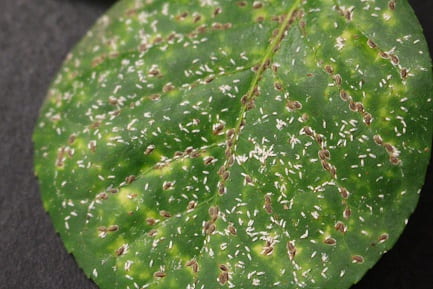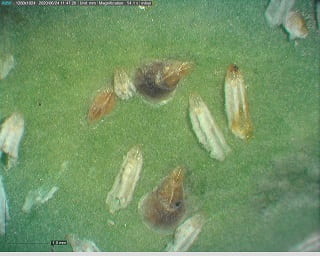–by Dr. Raymond Cloyd
Now is the time year when euonymus scale, Unaspis euonymi, is noticeable on evergreen euonymus, Euonymus japonica, and Japanese pachysandra, Pachysandra terminalis), plants in landscapes. Euonymus scale overwinters as a mated female on plant stems. Eggs develop and mature underneath the scale, and then nymphs (crawlers) hatch from eggs over a two to three-week period. The nymphs migrate along the stem and start feeding near the base of host plants. Nymphs can also infest adjacent plants by being blown around on air currents, which results in infestations not being detected until populations are extensive and damage is noticeable. Leaves eventually become spotted yellow or white (Figure 1). Plants located near structures such as foundations, walls or in parking areas are more susceptible to euonymus scale than plants growing in open areas that receive sunlight and are exposed to air movement.
Fig 1. Euonymus Scale Infestation On Euonymus Plants Located Near Building (Auth-Raymond Cloyd, KSU)
Extensive infestations of euonymus scale can ruin the aesthetic appearance of plants, causing complete defoliation or even plant death. Females are dark brown, flattened, and resemble an oyster shell. Males, however, are elongated, ridged, and white (Figures 2 and 3). Males tend to be located on leaves along leaf veins whereas females reside on the stems. There can be up to three generations per year in Kansas.
Fig 2. Male And Female Euonymus Scale On Leaf (Auth–Raymond Cloyd, KSU)
Fig 3. Close-Up Of Euonymus Scale Female (Brown) And Male (White) (Auth–Raymond Cloyd, KSU)
Cultural practices such as pruning out heavily infested branches, without ruining the aesthetic quality of the plant are effective in quickly reducing euonymus scale populations, especially this time of year. Be sure to discard all pruned branches away from the area.
Insecticide applications should have been applied in May through early-June (now is really too late!) when the nymphs are most active, which will help alleviate problems with euonymus scale later in the season. Insecticide active ingredients recommended for suppression of euonymus scale populations, primarily targeting the nymphs, include acephate; pyrethroid-based insecticides such as bifenthrin, cyfluthrin, permethrin, and lambda-cyhalothrin; potassium salts of fatty acids; and petroleum, mineral, or neem-based (clarified hydrophobic extract of neem oil) horticultural oils. Always check plants regularly for the presence of nymphs, which will help time insecticide applications.
Three to four applications performed at seven to 10-day intervals may be required; however, this depends on the level of the infestation. Euonymus scale is a hard or armored scale, so, in most cases, soil or drench applications of systemic insecticides such as imidacloprid are not effective in suppressing euonymus scale populations. However, the systemic insecticide dinotefuran, due to its high-water solubility (39,000 ppm), may provide suppression of euonymus scale populations when applied as a drench to the soil. Euonymus scale is susceptible to many different natural enemies (e.g. parasitoids and predators), including: braconid and ichneumonid wasps, ladybird beetles, green lacewings, and minute pirate bugs. However, natural enemies may fail to provide enough regulation to substantially impact extensive populations of euonymus scale. Furthermore, insecticides such as acephate; and many of the pyrethroid-based insecticides, including bifenthrin, cyfluthrin, permethrin, and lambda-cyhalothrin are very harmful to most natural enemies, so applications of these materials may disrupt any natural regulation or suppression.
For more information on how to manage euonymus scale and other scale insect pests
refer to the following extension publication:
Scale Insect Pests (MF3457 July 2019)
https://www.bookstore.ksre.ksu.edu/pubs/MF3457.pdf


